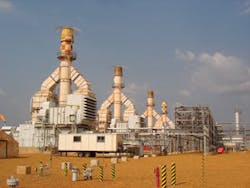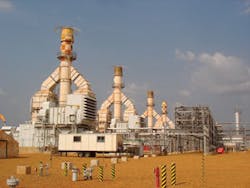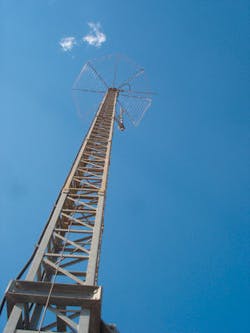An option available to petroleum producers for protecting facilities in high-lightning-risk areas is to install lightning-prevention arrays such as developed by Lightning Eliminators and Consultants Inc. (LEC), Boulder, Colo.
During the last 35 years, the company has developed lightning-strike prevention systems that various operators have installed in a variety of oil and gas facilities including upstream production, downstream refining, and offshore oil platforms. One recent example is the installation of the arrays in the Chad-Cameroon development project operated by Esso Exploration & Production Chad Inc., a unit of ExxonMobil Corp.
LEC says the zones of protection from their arrays provide continuous protection and replace lightning rods that can attract lightning and induce fields that pose a danger to electronic equipment.
Chad
The Chad-Cameroon development project currently includes five producing fields in the Doha basin in Chad: Kome, Bolobo, Nya, Maundoli, and Miandoum. Esso in 2006 began developing a sixth field, Maikeri, that will come on stream in 2007 and have about 20 producing wells. In 2006, the fields produced through 368 wells an average 155,000 bo/d, according to Esso in the project’s 2006 annual report.
To export the crude, Esso transports the heavy 20.5 gravity Doha crude through a 663-mile pipeline through Cameroon to an offshore marine export terminal.
LEC says Chad has some of the most intense, most frequent lightning strikes in the world, with about two lightning storms a week from mid May to early October. An isokeraunic number indicates thunderstorn activity, with a 30 indicating average lightning activity of about 13.7 strikes/sq mile/year. It says the oil development area in Chad has an isokeraunic number of 120, indicating about 41 strikes/sq mile/year.
With the facilities covering about 1.25 sq miles, LEC would expect them to endure about 51 lightning strikes/year.
Arrays
To protect the Chad facilities, including the central processing site and outlying gathering sites, Esso installed various lightning protection arrays.
For the oil production operation, LEC custom engineered, designed, and deployed interconnected systems for strike prevention and low impedance grounding, utilizing its Dissipation Array System (DAS).
LEC describes DAS as a charge transfer technology that is a comprehensive, preventive solution for modern lightning protection. The system prevents strikes by continually lowering the voltage differential between the ground and charged storm clouds to well below lightning potential.
The company says DAS has proven to be a preventative solution for lightning protection, substantially cutting storm-induced voltages as compared to the unprotected surroundings, thus eliminating the lightning strike risk.
To protect about 1.25 sq miles of the Chad facilities, including the central site encompassing about 0.5 sq miles and three separate gathering sites encompassing about 0.25 sq miles each, LEC took into account factors such as each facility’s location, size, shape, equipment, geography, and exposure to lightning activity.
To discharge structures of the voltage differential between the ground and charged storm clouds, it deployed DAS in various configurations across the protected sites. Stack arrays protect the turbine generators, which have protruding exhaust stacks (Fig. 1). U-bracket arrays protect buildings or structures with architectural or weight restrictions. Hemisphere arrays protect a telecom tower and high-mass lights used for nighttime illumination (Fig. 2).
While rim arrays prevent lightning strikes to floating roof storage tanks, the company deployed multiple retractable grounding assemblies (RGAs) to prevent arcing at the gap between the seal of the floating roof and the tank wall, caused by lightning storm and ground-current activity.
RGAs are devices that provide a direct connection to the tank roof from the tank wall with a wide, thick-braided wire cable wound on a heavy stainless steel reel, with tension held by spring loading. LEC says the path of impedance is kept to a practical minimum by the combination of the shortest path, wide braid, and constant tension.
In addition, an ultralow impedance grounding system transfers induced ground charges efficiently, since transient voltages such as lightning are affected by impedance while resistance pertains to DC voltage, according to LEC.
LEC says an appropriate number, sizing, and spacing of Chem-Rods, which use natural mineral chemicals to improve conductivity up to 10 fold more than traditional grounding rods, help reduce ground resistance with a target of less than 1 ohm. The company explains that reducing grounding impedance was important in Chad because the natural soil resistivity at various sites range from less than 30 ohms near a riverbank to more than 500 ohms on a sandy hill.
Since the installation more than 3 years ago, LEC says not a single lightning strike has hit the protected zones in Chad, and only once, when installers mistakenly put a closed-circuit television camera above a protected zone, did the facilities suffer a lightning strike, which destroyed the camera.
During the last 35 years, LEC says DAS installations, installed in thousands of locations in 55 countries, have accumulated more than 40,000 system-years of history with 99.85% no-strike performance.


